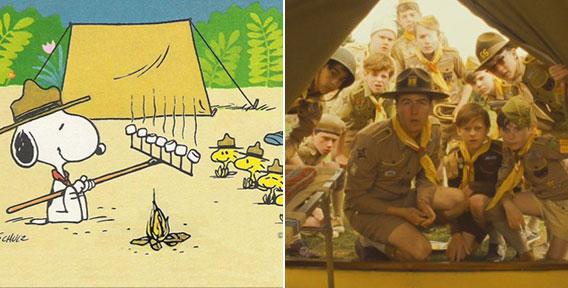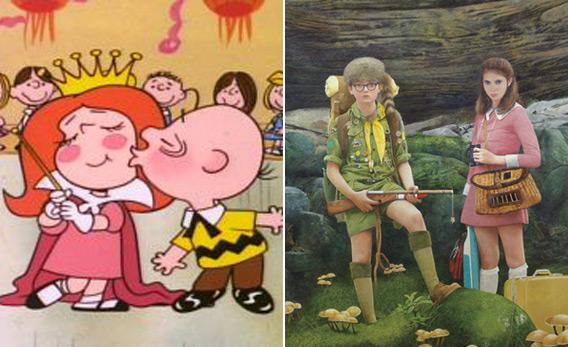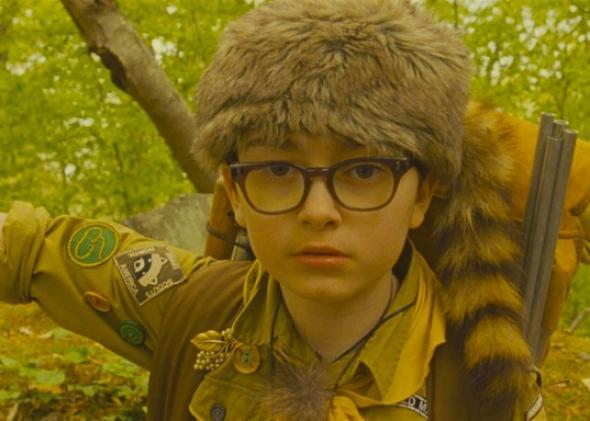Also in Slate: Listen to our interview with Wes Anderson, read Dana Stevens’ review of Moonrise Kingdom, and play Wes Anderson Bingo.
Wes Anderson wears his influences on the exquisitely tailored sleeves of his beige suit-jackets. He’s not alone in this among his generation (see, e.g., mashup artist Quentin Tarantino), but Anderson’s homages tend to be a bit higher brow—and often French: Truffaut, Malle, and Godard (along with Welles, Ashby, Scorsese, and Salinger).
There’s another influence that is less frequently mentioned, but is just as significant—and is more visible than ever in Moonrise Kingdom. Anderson makes no secret of this influence: In case there was any chance that the audience would miss it, he names the dog in the movie “Snoopy.”
This isn’t the first time Anderson has alluded to Charles Schulz’s Peanuts—and the specials of Peanuts director Bill Melendez. The critic Matt Zoller Seitz has analyzed Peanuts’ influence on Anderson at some length. In a video essay devoted to Melendez’s work, Seitz argues that, without Melendez, Anderson’s career would be “unimaginable.” And Seitz should know: In a December 1998 interview about the influence of A Charlie Brown Christmas on Bottle Rocket and Rushmore, Anderson told Seitz: “If I had to list my top three influences as a filmmaker, I’d have to say they are Francois Truffaut, Orson Welles, and Bill Melendez.”
Previously, this influence was most apparent in Rushmore, Anderson’s other coming-of-age film. In that same interview Anderson said that the film’s main character, Max Fischer, is “sort of a combination of Charlie Brown and Snoopy,” while Rosemary Cross was modeled on Charlie Brown’s teacher and the Little Red-Haired Girl (Charlie’s ever unattainable crush). Meanwhile, Anderson made Max’s dad a barber, just like Charlie Brown’s, not to mention Schulz’s.
Anderson has repeatedly paid tribute to Peanuts in his work. In Rushmore, this is most obvious when the Charlie Brown Christmas version of “Hark the Herald Angels Sing” plays in the background just as Max introduces Herman Blume (Bill Murray) to his father at the barber shop. Music from the Christmas special will appear again: In The Royal Tenenbaums, “Christmastime Is Here” plays during Margot Tenenbaum’s lunch with her father Royal. Other homages are more subtle: Notice the familiar pattern on Richie Tenenbaum’s rug, or just watch Seitz’s comparison of two scenes from Rushmore and A Charlie Brown Christmas about eight minutes into the video above.* And Anderson says on the commentary track for Royal Tenenbaums that the family beagle in that film was modeled on Peanuts’ pooch.

Side-by-side comparison. Left: Art from Peanuts. Right: Still from Moonrise Kingdom © Focus Features 2012.
Back to Moonrise Kingdom. Some of its sequences are remarkably cartoonish. When one character is struck by lightning, he looks more like he was hit by Acme dynamite: His face is blackened with soot, and he seems otherwise unharmed. And the scouts aren’t Boy Scouts, they’re Khaki Scouts, a fictional takeoff that’s reminiscent of Snoopy’s Beagle Scouts. Anderson has spoken often of his fondness for “self-contained worlds,” a penchant he says comes from Peanuts—and while all of Anderson’s worlds feel self-contained, that’s never more true than here, in which all the action literally takes place on a (fictional) island. The magic of self-contained worlds is also one of the central themes of the film: At the end of the movie we learn that Moonrise Kingdom takes its name from Sam and Suzy’s own secret place, a cove where they try to make a life of their own away from troubles back home.
It’s there that Moonrise’s hero bonds with his own Little Red-Haired Girl: Suzy. Suzy’s outfit, complete with pink dress, white collar, and, in some scenes, a pink cape, is almost identical to that of the Little Red-Haired Girl. Sam’s outfit may not mimic Charlie Brown’s as neatly, but he does wear a lot of yellow—and, as The Star-Ledger’s Stephen Whitty pointed out, at one point he even says, “Rats!”

Side-by-side comparison. Left: Art from Peanuts from Wikipedia. Right: Detail of the official poster for Moonrise Kingdom © Focus Features 2012.
We may think of the Charlie Brown specials as being for kids, but Anderson’s interest in them is far from childish. In that same Star-Ledger interview, Anderson told Seitz, “The main thing I love about that special is that it’s one of the saddest Christmas specials ever, and it’s about little kids who use the word ‘depression’ a lot.” Indeed, it’s because of their own profound sadness that Sam and Suzy connect. (Note, also, the dark and somewhat disturbing fate of the two dogs Anderson modeled on Snoopy.) Anderson is drawn to Peanuts for its own unique blend of the wonderfully fantastical and the terribly sad.
Previously
Wes Anderson Bingo!
Classic Cinema in 3 GIFs: Rushmore
Wes Anderson from Above
*Correction, May 29, 2012: This article originally misidentified the character Richie Tenenbaum as Chas Tenenbaum.
